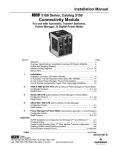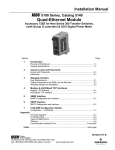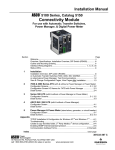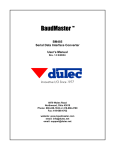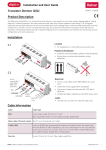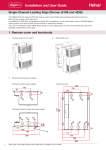Download Emerson 214A400 Switch User Manual
Transcript
Owner’s Manual ATS Annunciator Catalog 214A400, 214A401, 214A404 General DANGER is used in this manual to warn of high voltages capable of causing shock, burns, or death. ! WARNING is used in this manual to warn of possible personal injury. ! CAUTION is used in this manual to warn of possible equipment damage. There are three types of ATS (Automatic Transfer Switch) Annunciators. They are identified as follows: Catalog 214A400 Master Unit Catalog 214A404 Master Unit used with a Network Supervisor Catalog 214A401 Slave Unit Each installation must have a master unit; each master unit can support two slave units. Each unit can annunciate four ATSs. Therefore a master and two slave units can annunciate up to twelve ATSs. To annunciate more ATSs, additional masters and slaves can be added. ASCO Catalog 214A400, 214A404, and 214A401 ATS Annunciators are designed to provide remote visual status reporting and push button testing of ASCO automatic transfer switches. Each ATS must have a Group 1*, 5, 6, or 7 Microprocessor Controller with Accessory 72A Serial Communication Interface Option installed. *Note: Group 1 Controller must have version 8 or lower software (dash number on microprocessor). Ratings Master ATS Annunciator Catalog 214A400, 214A404 Nominal Input Voltage . . . . . . . . 16 V ac 50 or 60 Hz, . . . . . . . . . . . . or 12 or 24 V dc Volt-Ampere Burden ➀ . . . . . . . 10 VA max @ 16 V ac . . . . . . . 0.5 A max @ 24 V dc Environmental Temperature Range ---20˚C. to +70˚C. Transient Withstand . . . . . . . . per NEMA ICS 1---109 Surge Withstand (SWC) . . . . . . . IEEE Std 472---1974 . . . . . . ANSI C37.90A ---1974 Max total distance for Communication Line 4000 ft ➁ ➀ (Master with 2 Slaves) ➁ For greater distances contact ASCO. Table of Contents section-page Catalog 214A401 Slave ATS Annunciator Iinstallation . . . . . . . . . . . . . . . . . . . . . . . . . . . . . 1-2 Setting Up the ATS Annunciator . . . . . . . . . . . 3-5 Operation and ATS Testing . . . . . . . . . . . . . . . . 6 Troubleshooting . . . . . . . . . . . . . . . . . . . . . . . . . . 7 An experienced licensed electrician must install the ATS Annunciator. 50 Hanover Road, Florham Park, New Jersey 07932–1591 USA For sales or service call 1 800 800–2726 (ASCO) www.ascopower.com 381333–063 B ASCO POWER TECHNOLOGIES CANADA PO Box 1238, 17 Airport Road, Brantford, Ontario, Canada N3T 5T3 telephone 519 758–8450, fax 519 758–0876, for service call 1 888 234–2726 (ASCO) www.asco.ca Serial Communications Serial communications permits large amounts of information to be processed over a few wires. In the serial communications systems used by ASCO, each individual device in the system --- automatic transfer switch, bypass-isolation switch, ATS annunciator, etc. --- has a unique code, or address, that is assigned to it through DIP switches in the devices. According to the established ASCO serial communications rules, or protocol, each ATS annunciator and/or the network supervisor on the communication link “talks” to all automatic transfer switches and other elements being monitored on the link at the same time. They all “hear” what is being said, but only the device that is addressed responds. Sending and receiving requests and commands is done over the same pair of twisted wires linked in a network fashion from one device to another to form the communication link, or highway. This physical configuration comprises a network in which only the addressed device is permitted to go on line and respond to an inquiry. With this serial communications system, a minimum number of wires can be used to link the elements together. Without serial communications, it would take considerably more wires to accomplish the same thing. INSTALLATION The ATS Annunciator has been tested and is ready to use. Installation simply requires mounting, connecting power and communication wiring, and setting DIP switches. When unpacking the unit, locate the loose parts which are supplied in a separate kit. The kits contain the following parts: Master Kit 401091 label holder labels & 2 resistors face plate screws Slave Kit 401092 label holder labels, 2 resistors, & ribbon cable The Master ATS Annunciator can be readily identified by the front mounted key switch (to prevent unauthorized operation). You will find the key taped inside the back panel. Up to two Slave ATS Annunciators can be mounted directly above or below the Master. All three ATS Annunciators are then interconnected by means of ribbon cables. All external wiring for power and serial communication line connects to the Master ATS Annunciator. Observe the requirements of the National Electrical Code (especially Articles 725 and 800) and any local codes when interwiring. Mounting cover An Outline and Installation drawing (JS 387797) is included in the back of this manual. The two---part enclosure, which measures 10I wide x 6I high and 2I deep, is designed for mounting to the standard wall boxes listed on the drawing. After removing the front cover the hinged circuit board opens to the right to expose the mounting holes in the base. cover screws Figure 1. Cover removal. power wires, insulated ground wire, and communication cable hinged circuit board Loosen four screws to remove the cover as shown in Figure 1. Remove four screws and remove the face plate. Then remove the two left standoffs and swing the hinged circuit board to the right as shown in Figure 2. You will find the key taped to the back panel. Run the power wires (and insulated ground wire) and communication cable (twisted pairs) through the center hole in the back of the enclosure, then to the right through the notch in the circuit board. Attach the ATS Annunciator to the wall box by using the mounting holes that line up. Swing the circuit board closed again. Reinstall the two standoffs and tighten them securely. Reinstall the face plate with four screws. Connecting Slave ATS Annunciators Connect the Slave ATS Annunciator(s), when used, to the Master. Remove the adhesive labels from the slotted openings as shown in Figure 2. Then run the ribbon cable between ATS Annunciators and plug each end into the adjacent sockets. Two Slaves may be connected to one Master either by above and below arrangement or two below arrangement. See the Outline and Installation drawing for details. slotted opening for ribbon cable and removable label standoff face plate Figure 2. Hinged circuit board (Master). 1 Power Wiring INSTALLATION (continued) The Master ATS Annunciator can be powered by either an ac or dc source (but not both) as shown on the Outline and Installation drawing 387797 and in Figure 3. For ac wiring use a Class 2 bell transformer with a 120 V ac primary and a 16 V ac secondary (12 VA minimum). Connect the ac wiring to terminals 9 and 10; connect the ground to terminal 1. For dc wiring connect a 12 or 24 V dc power source (750 ma) to terminals 7 (---) and 8 (+). Acceptable Communication Cable shield gnd T+ Standard 80˚ C T--R+ R--resistor on Master 1 only Belden 1419A Belden 9842 Belden 9829 Alpha 6202C Alpha 6222C Plenum Rated ! Belden 89729 Belden 82729 Alpha 58902 To prevent damage do not energize the circuit at this time. Figure 3. Terminal block (Master). Located on right side of circuit board. Communication Wiring Connect one end of the transmit and receive communication cable (twisted pairs) to terminals 3 through 6 on the Master ATS Annunciator as shown on the Outline and Installation drawing 387797 and in Figure 3. Refer to the Daisy Chain and Star configuration hook up drawings for typical arrangements. Use communication cable specified in Figure 3. This cable has two twisted pairs (4 wires) and an overall shield. All twisted pair shields must be connected to terminal 2 for grounding. The earth ground is connected to terminal 1 and internally jumpered to terminal 2. Two resistors are supplied. Connect one resistor (390 Ohm, 1/4 Watt, 5%) between terminals 5 and 6 on Master 1 only. See Figure 3. (The other resistor will be connected at the automatic transfer switch furthest away.) Two twisted pairs can be connected to the ATS Annunciator terminal block. Use a separate terminal block (not supplied) mounted in a separate wall box if more connections are necessary, as shown in Figure 4. Figure 4. Typical separate terminal block. Networks for Interconnecting ATS Annunciators and ATSs Refer to Drawing JS 401900 Sheets 1 through 4 for typical interconnection schemes. The Daisy Chain configuration utilizes a single run of communication cable with all of the equipment connected in parallel as shown on Sheet No. 1. This type of network utilizes the least amount of cable and is probably the most popular approach when long line runs are anticipated. Depending on the desired reliability of the system, some consideration should be given to the effect of a cable break. If the cable is broken all ATSs beyond the break will lose their communication. It should be kept in mind that annunciator lamps will flash if a disconnection occurs. Also, a disconnection of the communications cable will in no way impair the operation of the automatic transfer switch. Star networks can be used as an alternate configuration as shown on Sheet No. 2. With this approach, greater reliability can be achieved because a disconnect of the cable between the junction box and the ATS will only impair one switch. Depending on location of this equipment it may sometimes be advantageous to use combinations of Daisy Chain and Star networks. Typical configurations are shown on Sheets No. 3 and 4. 2 SETTING UP THE ATS ANNUNCIATORS Catalog 214A400, 214A404 Master ATS Annunciators Catalog 214A401 Slave ATS Annunciator Master ATS Annunciator factory default settings Slave ATS Annunciator factory default settings Figure 5. DIP switches in Master. Before applying power to the ATS Annunciators, the DIP switches must be set to select the number of Masters and Slaves, Master Address, and the addresses of each automatic transfer switch connected. Refer to Figures 5 and 6 for the location of DIP switches. See Charts 1, 2, 3, and 4 for position of actuators for each setting. Figure 6. DIP switches in Slave. 5 Controller menu selection for the serial communication baud rate must be set to 9600. Set Number of Slaves DIP switch S1 shown in Figure 6, (on the left side of each Slave) selects the number of the Slave (either 1 or 2). Refer to Chart 3. For example, if only one Slave is used, depress the actuators shown in the top figure (setting for Slave 1). If two Slaves are used, set one to the setting for Slave 1 and on the other Slave depress the actuators shown in the lower figure (setting for Slave 2). Set Number of Masters and Master Address ASCOBUS I communication protocol supports single– and multi–master, daisy chain, and star configurations. Group 7/7A and 5 Controllers can be connected on the same network. In this case the Group 5 menu item selecting the serial communication baud rate must be set to x9600. When more than one Master is being used, one Master must be selected as the Lead Master. Then the Lead Master must be told how many other masters there are. DIP switch S6 shown in Figure 5 on the Master ATS Annunciator selects how many Masters are being used (up to seven) and their addresses. Actuators 1 through 3 set the number of Masters (Chart 1 ) and actuators 4 through 6 set their addresses (Chart 2). For example, if only one Master is used, actuators 1 through 6 should be down (off). If more than one Master is used, select one as a Lead Master and set all other Masters to different address. To select the ASCOBUS II communication protocol, the DIP switches S6 actuators 1,2,3 must be set to ON position (ATS Annunciator must be deenergized). With ASCOBUS II protocol selected, Group 1 and 5 Controllers can be connected on the same network and the only configuration supported is the daisy chain configuration with single master annunciator and up to 2 slaves (see drawing 401900). In this case the Group Setting the ATS Address Number DIP switches S2, S3, S4, and S5 on the ATS Master (Figure 5) and Slave Annunciators (Figure 6) are used to set the unique address number for each ATS. Up to 32 ATSs can be accommodated on a system utilizing three Masters and five Slaves. Actuator 1 must be on (up) for each address being used. Refer to Chart 4 for selecting a unique address number for each ATS. One DIP switch is used for each ATS. For example, ATS 1 would use address 00 so set DIP switch S2 (on the Master) with actuators 2---6 down (off). ATS2 would use address 01 so set DIP switch S3 (on the Master) with actuator 6 up (on). Remember to move actuator 1 up (on) for each DIP switch being used! Refer to Table D at the back of this manual. ATS Label Holder The ATS Annunciator is labeled for ATS1, ATS2, ATS3, and ATS4. Included with each ATS Annunciator is an adhesive–backed label holder with labels for ATS5 ---12 and some blank labels. Label each ATS Annunciator with the ATS numbers that are addressed in it. Fill in Table D at the back of this manual. 3 SETTING UP THE ATS ANNUNCIATORS 4 SETTING UP THE ATS ANNUNCIATORS 5 OPERATION Catalog 214A400, 214A404, and 214A401 ATS Annunciators communicate with ASCO automatic transfer switches to report their status. Each automatic transfer switch is continuously polled and reports its status back to the ATS Annunciator. Lights on the front indicate which automatic transfer switches are connected to the normal source or emergency source. Source availability is also reported. to control their operation. A key switch prevents unauthorized operation. The Transfer Test push button simulates a normal source outage and transfers the individual load to the emergency source, if available. When the same push button is pressed again, it signals the automatic transfer switch to retransfer back to normal immediately. A Time Delay Active push button bypasses any transfer time delay in process (Feature 2B or 3A). Lights above each push button indicate that the automatic transfer switch is in the test mode and in a time delay mode. In addition, the ATS Annunciators can send commands to individual automatic transfer switches HOW TO TEST AN AUTOMATIC TRANSFER SWITCH FROM THE ATS ANNUNCIATOR 1. Insert the switch key and turn it clockwise to the Unlock position as shown in Figure7. 2. Select the number of the automatic transfer switch you want to test and find the Transfer Test push button below the ATS number on the bottom row. 3. Press and hold the Transfer Test push button until the amber light above it starts flashing. 4. Observe that the Emergency Source Available red light comes on indicating that the generator has started. 5. Observe that the Load Connected to Emergency red light comes on (Normal light off) indicating that the ATS has transferred. 6. Press the Transfer Test push button again to end the test. The flashing amber light goes off. Note: If Feature 3A Retransfer to Normal Time Delay is used (Time Delay Active amber light comes on) the retransfer may not occur for up to 30 minutes. To bypass this time delay press the Time Delay Active push button below the amber light. 7. Observe that the Load Connected to Normal green light comes on (Emergency light off) indicating that the ATS has retransferred. Note: The Emergency Source Available red light goes off when the emergency source is no longer available. 8. When testing is completed, turn the key switch counterclockwise to the Lock position and remove the key. Note: If Feature 2B Transfer to Emergency Time Delay is used (Time Delay Active) amber light comes on) the transfer may not occur for up to 5 minutes. To bypass this time delay press the Time Delay Active push button below the amber light. status lights Load connected to Source available Time delay active key switch Time delay bypass push button Transfer test Transfer test push button Figure 7. ATS Annunciator (Master) 6 TROUBLE-SHOOTING Table A. Trouble Shooting the ATS Annunciator Problem Probable Cause Corrective Action 1. Normal and Emergency lights flash alternately on all ATS Annunciators. No communication made. Incorrect, broken, or shorted wiring between ATSs and ATS Annunciators. Recheck wiring; check for shorted or open circuits. Be sure correct twisted pairs are connected. 2. Normal and Emergency lights flash alternately on only one Annunciator. No communication made. Addresses on ATSs do not correspond to addresses on ATS Annunciator. Recheck address settings in ATS Annunciator and ATS Control Panels. They must be the same. 3. Normal and Emergency lights flash for only one ATS column (not alternately) Communication lost to that ATS due to no power to ATS location. Check power and communication lines at all ATSs. 4. Normal and Emergency lights flash for all ATS columns (not alternately) Communication lost due to power failure at all ATSs, or broken or shorted communication line. Check power and communication lines at all ATSs. 5. When Transfer Test is pressed amber light does not flash. Key switch on Master ATS Annunciator in Lock position. Insert key and turn it to Unlock position. 6. When Time Delay Bypass is pressed amber light does not go off. Key switch on Master ATS Annunciator in Lock position. Key switch was turned to Lock before test completed. Insert key and turn it to Unlock position. If corrections do not resolve the problem, call your local ASCO Power Technologies or Authorized Representative Office, or ASI. Furnish the Serial No. and Catalog No. from the transfer switch nameplate. 7








